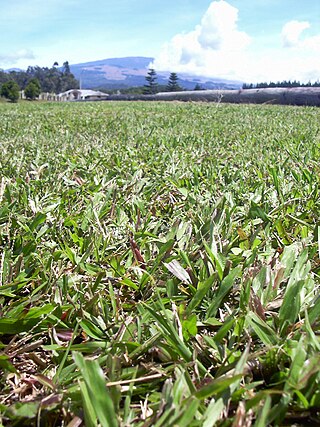
Platygonus is an extinct genus of herbivorous peccaries of the family Tayassuidae, endemic to North and South America from the Miocene through Pleistocene epochs, existing for about 10.289 million years. P. compressus stood 2.5 feet tall.

Axonopus compressus is a species of grass. It is often used as a permanent pasture, groundcover, and turf in moist, low fertility soils, particularly in shaded situations. It is generally too low-growing to be useful in cut-and-carry systems or for fodder conservation.

Fossilworks was a portal which provides query, download, and analysis tools to facilitate access to the Paleobiology Database, a large relational database assembled by hundreds of paleontologists from around the world.

Mylohyus is an extinct genus of peccary found in North and Central America. It first evolved during the Late Miocene and became extinct at the end of the Pleistocene, around 12,000 years ago, during the Late Pleistocene megafaunal extinction.

Jeletzkytes is an extinct genus of scaphatoid ammonite from the Upper Cretaceous (Maastrichtian) of North America named and described by Riccardi, 1983. In overall form Jeletzkytes closely resembles the genus Scaphites.

The island glass lizard is a species of lizard in the family Anguidae. The species is endemic to the southeastern United States.

Tremanotidae is an extinct family of Paleozoic fossil molluscs with isostrophically coiled shells. They occupy an uncertain position taxonomically: it is not known whether they were (gastropods or monoplacophorans.
Rhabdognathus is an extinct genus of dyrosaurid crocodylomorph. It is known from rocks dating to the Paleocene epoch from western Africa, and specimens dating back to the Maastrichtian era were identified in 2008. It was named by Swinton in 1930 for a lower jaw fragment from Nigeria. The type species is Rhabdognathus rarus. Stéphane Jouve subsequently assessed R. rarus as indeterminate at the species level, but not at the genus level, and thus dubious. Two skulls which were assigned to the genus Rhabdognathus but which could not be shown to be identical to R. rarus were given new species: R. aslerensis and R. keiniensis, both from Mali. The genus formerly contained the species Rhabdognathus compressus, which was reassigned to Congosaurus compressus after analysis of the lower jaw of a specimen found that it was more similar to that of the species Congosaurus bequaerti. Rhabdognathus is believed to be the closest relative to the extinct Atlantosuchus.

Potamogeton compressus is a species of aquatic plant known by the common names grass-wrack pondweed, flatstem pondweed and eel-grass pondweed.

Gymnites is a genus of ammonoid cephalopod from the Middle Triassic belonging to the ceratitid family Gymnitidae. These nektonic carnivores lived during the Triassic period, the Anisian age.

The Paleobiology Database (PBDB) is an online resource for information on the distribution and classification of fossil animals, plants, and microorganisms.

Hemipneustes is an extinct genus of sea urchins belonging to the family Holasteridae.
Phragmolites is an extinct genus of molluscs in the family Bucaniidae, paleozoic molluscs of uncertain position possibly being either Gastropods or Monoplacophorans in the superfamily Bellerophontoidea.

Ptyctodus is an extinct armour-plated fish of the late Devonian. Ptyctodus belongs to the family Ptyctodontidae and is of the class Placodermi. They share a close resemblance to modern day chimaeras (Holocephali). Fossils of this armour-plated fish have been found in locations such as in Russia, the Michigan Basis, and Arizona, United States.

Sivatheriinae is an extinct subfamily of giraffids characterized by their robust size, short limbs, and the presence of large complicated ossicones in males. These animals lived in Asia, Africa, and parts of Europe from the late Miocene and early Pleistocene.













